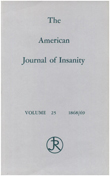Smaller neuron size in schizophrenia in hippocampal subfields that mediate cortical-hippocampal interactions
Abstract
OBJECTIVE: The goal of this study was to characterize the hippocampal formation in patients with schizophrenia by measuring neuron density, neuron size, and variability of neuronal axis orientation. METHOD: Brain tissue was obtained at autopsy from 14 prospectively accrued elderly patients with chronic schizophrenia and 10 age-compatible individuals without psychiatric disorder. Eight hippocampal regions of interest and two internal control regions (primary motor and visual cortices) were identified on Nissl-stained sections. Morphometric measurements were made without knowledge of diagnosis by means of a computer-based image analysis system. RESULTS: The patients exhibited smaller neuron size in the hippocampal regions relative to the control regions, which was significant only for the subiculum, CA1, and layer II of the entorhinal cortex. Neuron size in the control regions was nearly identical in the two groups. No significant differences in neuron density or in variability of neuronal axis orientation were identified for any region. There was no correlation between neuron size in any area and several potentially confounding variables (age, post- mortem interval, neuroleptic exposure, sex, brain hemisphere studied, duration of illness), with the exception of a negative correlation with age in layer II of the entorhinal cortex. Regression analyses indicated that the findings could not be attributed to these age effects. CONCLUSIONS: The subiculum, entorhinal cortex, and CA1 are the major subfields of the hippocampal region that maintain the afferent and efferent connections of the hippocampus with widespread cortical and subcortical targets. The smaller size of neurons in these subfields may reflect the presence of structural or functional impairments that disrupt these connections, which in turn could have important behavioral sequelae.
Access content
To read the fulltext, please use one of the options below to sign in or purchase access.- Personal login
- Institutional Login
- Sign in via OpenAthens
- Register for access
-
Please login/register if you wish to pair your device and check access availability.
Not a subscriber?
PsychiatryOnline subscription options offer access to the DSM-5 library, books, journals, CME, and patient resources. This all-in-one virtual library provides psychiatrists and mental health professionals with key resources for diagnosis, treatment, research, and professional development.
Need more help? PsychiatryOnline Customer Service may be reached by emailing [email protected] or by calling 800-368-5777 (in the U.S.) or 703-907-7322 (outside the U.S.).



